Home » Gemstones » American Gemstones » California
California Gemstone Mining
California produces a variety of gemstones but is especially known for its tourmaline.
Author: Hobart M. King, PhD, GIA Graduate Gemologist
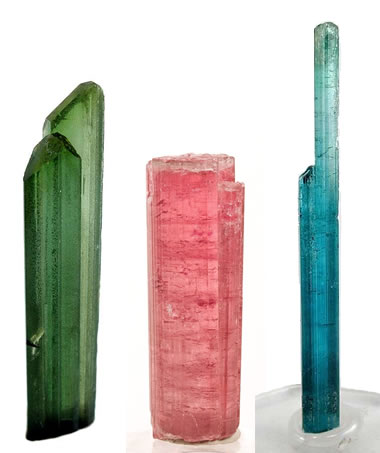
California Tourmalines: Three beautiful tourmaline crystals from pegmatites in southern California. The green elbaite is from the Little Three Mine near Ramona in San Diego County. It measures approximately 5.0 x 1.0 x 0.7 centimeters. The pink rubellite is from the Stewart Mine, Tourmaline Queen Mountain, in San Diego County. It measures approximately 3.9 x 1.4 x 1.2 centimeters. The blue indicolite is from the Maple Lode Mine near Aguanga in Riverside County. It measures approximately 5.7 x 0.5 x 0.4 centimeters. Specimens and photos by Arkenstone / www.iRocks.com.
Native Americans - The First Miners
Native Americans were mining and using gemstones in many parts of California long before recorded history. Bone and shell were some of the first materials that they used. Bone was available from their food preparations. Shells were easily acquired at California beaches and from streams in many parts of the state. These materials were easily drilled to make pendants and necklaces. They were also easily sewn onto clothing.
Table of Contents
Over 1000 years ago, Native Americans learned to quarry soapstone on Santa Catalina Island and, using tools made from quartz and flint, fashioned it into ornaments, small sculptures, beads and utilitarian items. [1] They transported these items back to the mainland in canoes and traded them across broad geographic areas.
Then, at least 500 years ago, Native Americans began mining California turquoise. Archaeologists learned about their turquoise mining from tools found at ancient mining sites in San Bernardino County. [2] Native Americans also searched for tourmaline and used pieces of the colorful mineral as ornaments. [3] Native Americans were California’s first miners, first jewelers and first gemologists.
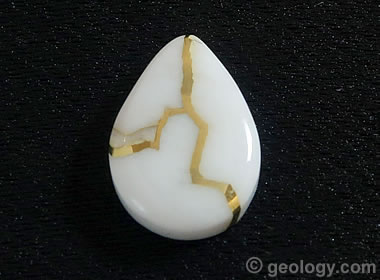
California Gold in Snow White Quartz: Almost never seen in jewelry is a cabochon cut from a piece of the "California Mother Lode". A few lapidary artists have cut these novelty gems that are an especially fitting tribute to California's mineral heritage. The example above is a piece of white vein quartz cut by a few thin veins of native gold. Earrings, rings and pendants made with these cabs are never seen in jewelry stores. On occasion you might find such jewelry and loose cabs in California rock shops and other stores that cater to gold prospectors, mineral collectors and goldbugs. The cabs are not cheap! They are often sold by the carat, but the buyer pays a price that often is calculated with the assumption that the entire gem consists of 24-karat gold - and then a premium is added on top. Why? Quartz with the properties and the gold to make a nice gold-in-quartz cab is really rare and worth its weight in gold. Perhaps it is the only gem where both karats and carats are used in the pricing!
California Tourmaline
Tourmaline has been mined in California for over 100 years. On the basis of cumulative dollar value, it is the leading gem material that has been mined in the state. Commercial tourmaline mines began operating in the late 1800s. By the end of the century, a healthy mining and export industry had been established.
|
Some of the first important customers of the early California tourmaline mines were in China. Chinese craftsmen used California tourmaline to make snuff bottles, jewelry, and many other items. Some of their products were made for Chinese royalty who enjoyed the color of pink tourmaline. [4]
Almost all of the tourmaline produced in California is from pegmatite deposits in Riverside and San Diego Counties. Mines in this area have produced more gem-quality tourmaline and mineral specimens than any other deposits in the northern hemisphere. [3]
California tourmalines occur in a wide variety of colors. The typical green and pink gems are produced in good quantity. Red and blue tourmalines are also found. Bicolor and tricolor crystals with lateral and concentric color zoning are also produced. Pink and green bicolor crystals are used to facet the popular “watermelon tourmalines.” California tourmalines are used to produce faceted gems, small carvings and cabochons. Some of the most attractive and perfect crystals are sold as mineral specimens. Specimen-grade tourmaline often sells for a higher price than facet-grade tourmaline.
Hunt For Gems - Keep What You Find!There are over 100 mines in the United States where anyone can visit, pay a small fee, look for gems and minerals, and keep what they find. For a large list of these mines, visit our Fee Mining Page on RockTumbler.com. |
| Name of the Mine | Minerals Often Found There |
| Benitoite Mining Company | Benitoite |
| Gold Prospecting Adventures | Gold |
| Himalaya Mine | Tourmaline, quartz crystals, lepidolite, topaz, morganite, and other pegmatite minerals |
| Modoc National Forest | Obsidian |
| OceanView Mine / Pala Chief Mine | Tourmalines, kunzites, morganites and more. |
| Roaring Camp Mining Company | Gold |
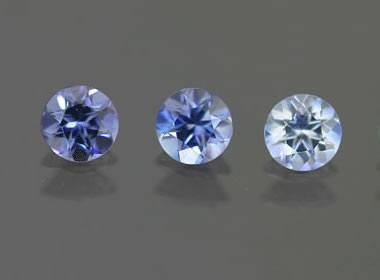
Benitoite - California's Official Gemstone: Benitoite is often cut into round brilliants because of its high refractive index and dispersion. Cutters must orient benitoite carefully to take full advantage of its pleochroism. Specimens and photo by TheGemTrader.com.
Benitoite - California's State Gem
Benitoite is an extremely rare barium titanium silicate mineral named after San Benito County, California - the location where it was first found and described in 1907. There it occurs in a host rock of blue schist where the benitoite crystals formed in fractures from hydrothermal fluids. Benitoite is known to occur in just a few other locations worldwide. The Dallas Gem Mine in San Benito County is the only place in the world where gem-quality benitoite is found and where benitoite is found in specimen-quality crystals.
When cut as a gemstone, benitoite has an appearance and optical properties that are similar to sapphire. Most specimens are blue to violetish-blue, although a few rare orange specimens are known.
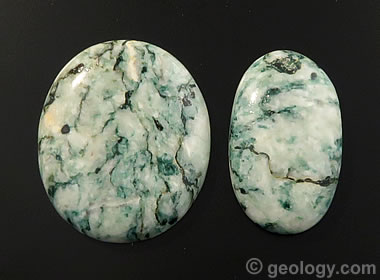
California Mariposite: Mariposite is the name of a green and white metamorphic rock found in the Mother Lode country of California. It often contains enough gold that it is mined as an ore. Its presence was used by many "gold rush prospectors" as a sign that they were "close to the gold". Mariposite is an interesting material that is sometimes cut into cabochons or used to make tumbled stones. Some people think that it should be named the official "State Rock" or "State Gemstone" because of its distinctive appearance and association with California's gold history. Learn more about mariposite here.
Benitoite can be easily separated from sapphire because it has a much higher birefringence and often exhibits birefringence blink. Crystals of benitoite are usually small and are rarely large enough to cut gems over three carats.
The California Legislature named benitoite the "Official Gemstone of California" in 1985. Because of its rarity and high price, you are not going to find it for sale in the typical mall jewelry store. However, if you can afford the high price and are lucky, you might be able to purchase it in jewelry made by a designer who specializes in rare and expensive gems.
Nice benitoite is especially prized by mineral collectors. They are usually willing to pay a lot more than folks who want to buy the crystals to cut faceted stones. They will not allow good crystals to be sawn and put to a faceting machine.
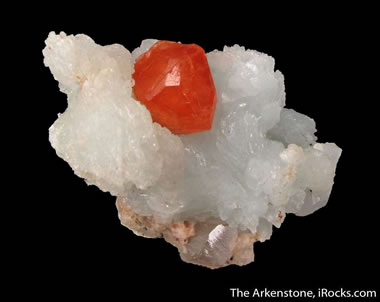
California Spessartine Garnet: This specimen was found at the Little Three Mine, Ramona District, in San Diego County. The garnet crystal measures about 1 centimeter, and it rests on a base of albite which measures about 3.3 x 2.9 x 2.7 centimeters. Specimen and photo by Arkenstone / www.iRocks.com.
California Garnet
Some of the highest-quality spessartine garnets in the world have been found in the pegmatites of San Diego County near the community of Ramona. Although very little is being found or mined today, Ramona spessartines are famous for their orangy yellow to yellowish orange color.
Most of the spessartine production came from just a few mines, which included the Little Three, the A.B.C., the Spaulding, and the Hercules Mines. The Little Three mine has been the world's most important source of facet-quality spessartine and spessartine mineral specimens. It has done this in over a century of sporadic production. In addition to spessartine, significant amounts of topaz, tourmaline, beryl, quartz and hessonite garnet have been found in the area of these mines. [5] [6]
Gem-quality and specimen-quality grossularite garnet has been found at several locations in California. Localities are in Siskiyou, El Dorado, Fresno, Tulare, Butte, and Orange Counties.
California Turquoise
The production of turquoise has a long history in California. Archaeologists learned about Native Americans mining turquoise from tools found at ancient mining sites in the area that is now San Bernardino County. Commercial miners have produced turquoise nodules and vein turquoise from deposits in San Bernardino, Imperial, and Inyo Counties. Today, very little turquoise is produced in California, and it is difficult to find California rough or finished cabochons - even if you search diligently for them.

California Agates: You can find an enormous number of agates in California, each with its own distictive appearance, colors and properties. These two cabochons are plume agates. The one on the left is Horse Canyon Plume Agate and the one on the right is Wingate Plume Agate.
The Epicenter of Gems in California
San Diego County has been one of the best gemstone-producing areas in North America for over 100 years. Pegmatite deposits there host many different types of gem materials. In addition to tourmaline, the mines produce garnet, morganite, aquamarine, topaz and spodumene. A few of the famous mines and their products include:
- Tourmaline Queen Mine (tourmaline, garnet)
- Elizabeth R Mine (morganite, aquamarine)
- Anita Mine (spodumene, morganite)
- White Queen (morganite)
- Pala Chief Mine (kunzite)
- Tourmaline King Mine (tourmaline)
- Stewart Mine (morganite)
- Himalaya Mine (tourmaline, beryl)
- Little Three Mine (topaz)
- Pack Rat Mine (aquamarine, garnet)
- Beebe Hole Mine (aquamarine, spodumene)
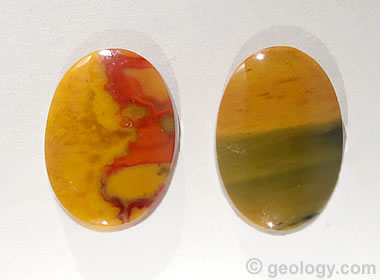
California Petrified Wood: Lapidary-quality petrified wood has been found at many locations in California. It is often colorful, sometimes shows nice wood grain, and often makes beautiful cabochons.
Diamonds in California?
For the last two centuries, millions of people have gone to California streams to pan for gold. They have very carefully searched through millions of tons of sediment. Perhaps it is not surprising that a few small diamonds were also found. The surprise is that remarkable numbers of diamonds have been found at a number of locations. Unfortunately, none of these locations had enough diamonds to support a commercial diamond mine, and a pipe that delivered these diamonds to the surface was never discovered.
At one location in Butte County, north of Oroville, native gold, native platinum, and hundreds of gem-quality diamonds were recovered from Tertiary-age gravels of the Ione Formation. If you want to learn more and see a detailed map of where these diamonds were found, check out our article titled "Diamond Mines in the United States". It includes a section about diamonds found in California.
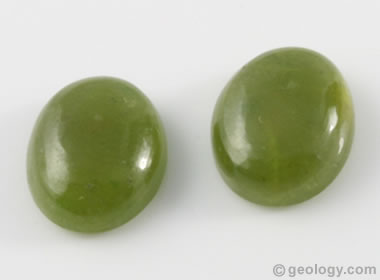
California Vesuvianite: Vesuvianite is a complex silicate mineral also known as "idocrase". It is found in a few places in California where limestone has been subjected to contact metamorphism. It is usually brown, yellow or green. The green material can be especially attractive. When transparent and faceted it can look like peridot. When translucent and cut en cabochon it looks very much like jadeite. Vesuvianite is an exotic gem not often found in jewelry stores.
The Diversity of California Gems
California is an enormous state that spans a wide variety of geologic environments, many of which have the potential to be gem-forming. John Sinkankas, in his survey of North American gemstones, provides a large list of gems that have at least been found as an "occurrence" in California. Some of the most notable from that list include: andalusite, apatite, axinite, azurite, benitoite, beryl, calcite onyx, colemanite, cordierite, diamond, feldspar, fluorite, garnet, howlite, jade, lapis lazuli, lepidolite, magnesite, mariposite, obsidian, opal, quartz, rhodonite, orbicular rhyolite, serpentine, sphene, spodumene, steatite, thomsonite, topaz, tourmaline, turquoise, variscite, vesuvianite, and others.
Don't Overlook Quartz!
It's easy to get distracted by gems such as tourmaline, turquoise, benitoite, and diamonds, and overlook quartz. Anybody can find quartz of gem quality in California. Agates can be found in many streams and beaches. Jasper can be found in fields and in the desert. Petrified wood has been found in many locations and palm root at a few more. Less likely - but possible finds - are the transparent quartz varieties such as amethyst, citrine, and smoky quartz.
These gem materials are especially easy to find after a rain when the dust is washed off of the rocks and the gem material glistens from a thin coating of water. Facet-quality quartz can be found in a variety of colors. They are the perfect gem materials for a beginner, and you can polish them into beautiful tumbled stones using a rock tumbler for a small investment and a little practice. You might become a rockhound!

California Petrified Palm Root: In addition to petrified wood, you can often find petrified roots as fossils. This cabochon was cut from petrified palm root found in California. It has a very interesting pattern that is a preservation of the root's cellular structure.
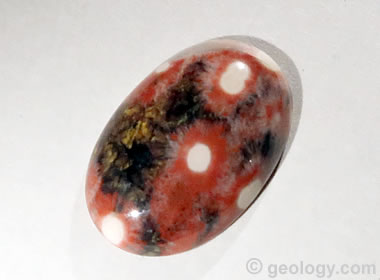
California Morgan Hill Jasper: Just as there are many types of agates in California, there are many varieties of jasper. Morgan Hill is an extremely colorful and interesting jasper that is full of orbicular features, often with a concentric structure.
| California Gemstone Information |
|
[1] Explore the Channel Islands: Native Americans and Steatite Trading, An article that once appeared on the RAIN Public Internet Broadcasting Website. Now hosted on the Internet Archive website.
[2] Turquoise, in An Overview of Production of Specific U.S. Gemstones, United States Bureau of Mines Special Publication 14-95, Published on the United States Geological Survey Website. [3] Tourmaline, in An Overview of Production of Specific U.S. Gemstones, United States Bureau of Mines Special Publication 14-95, Published on the United States Geological Survey Website. [4] Tourmaline History and Lore, in Tourmaline, GIA Gem Encyclopedia, Article published on the Gemological Institute of America Website, accessed March 2018. [5] Secrets of the Gem Trade (second edition), by Richard W. Wise, Brunswick House Press, 385 pages, 2016. [6] Spessartine Garnet from Ramona, San Diego County, California, by Brendan M. Laurs and Kimberly Knox; Gems & Gemology, Pages 278-285, Winter 2001. |
| More Gemstones |
 |
Tourmaline |
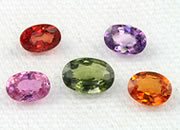 |
Fancy Sapphires |
 |
Diamond |
 |
Canadian Diamond Mines |
 |
Birthstones |
 |
Pictures of Opal |
 |
Fire Agate |
 |
Blue Gemstones |

Find Other Topics on Geology.com:

|

| ||

|

| ||

|

| ||

|

|

